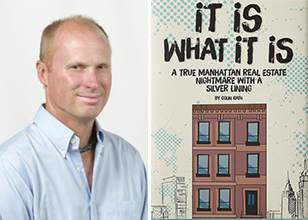As Colin Rath says in his recently self-published book “It Is What It Is: A True Manhattan Real Estate Nightmare with a Silver Lining,” “One goes through many rites of passage when becoming a New Yorker…”
You ain’t a real New Yorker if you don’t have the obligatory “it was such a disaster” real estate-related story to wield. Maybe you’ve had bed bugs … twice — or foolishly passed on the opportunity to buy in Carroll Gardens in the 1980s for under $100,000 thinking this Brooklyn thing would never catch on.
In Rath’s case, it is a combo development/downturn nightmare. Winning story aside, the inflammatory tone of his memoir could mean that Rath may not be invited to any dinner parties for the foreseeable future.
Comprised of a continuous thread of zings, insults and downright slurs like, “No surprise there. [In reference to paying $5,000 for a commitment letter he never received] I was dealing with Russians,” and “an Italian steroid boy with a crew cut” about a construction manager, “IIWII” may have more aptly been released during Festivus, because it’s less an educational tale than an airing of grievances and to reference Seinfeld — which Rath does several times throughout the book — he “names names.”
“IIWII” chronicles Rath and his wife Pam’s foray into Manhattan real estate development. High off the success of creating a unique home at 121 West 15th Street, one which features curved ceilings, comic book wallpaper, a two-story waterfall and a koi pond, the Raths decide to purchase the building adjacent to theirs – an SRO filled with rent-stabilized tenants — to expand their own home and create a unique green-friendly eight-story boutique condo development.
This project is coined “Valhalla” – a sort of Manhattan mini-version of the infamous Florida Versailles debacle — and quickly gets out of hand and wallet. Geothermal wells, a rotating three-car garage, and a curved three-story cantilevered penthouse don’t come cheap … or easy. Even during the previous market peak when the Raths bought 123 West 15th Street, they struggled to find proper financing to fund their vanity project. Over the next six years, a combination of bad decisions and worse luck find the Raths involved in a family intervention, multiple lawsuits and being foreclosed upon, their dream dashed.
A cautionary tale for would-be Manhattan developers, here’s what we took away:

121 West 15th Street in the West Village
DO vet who you partner with: Rath hired a sailing buddy, Howard, a disbarred attorney inexperienced in overseeing a construction project as his owner’s rep. He also signed on another friend, Jim, as a “junior owner” who had no equity, credit and who “was known to not pay his bills on time.” As a result of these two not-so-brilliant decisions, Rath ultimately had to pay thousands to buy out Jim and paid costly fines because Howard failed to notice major fraud in the foundation or possibly turned a blind eye to kickbacks. Lastly, because Rath chose to work with a construction team headed by a shady foreman named Richie, when an accident occurred involving the schist wall crashing and injuring a worker, the project was shut down, suits were filed and hefty fines were doled out.
“DON’T use an architect untested in the ways of Manhattan when you’re creating groundbreaking design”: Rath opts to use a yet-to-be-licensed architect, who while amenable to Rath’s design aesthetic, is slow and unfamiliar with the nuances of the trade in Manhattan, particularly the ways of the Department of Buildings.
DO pay close attention to detail: “IIWII” is peppered with so many grammatical, punctuation and formatting errors, not to mention the barely-legible font size, that if Rath handled his development project the way he handled the writing and publishing of his book it is no wonder it went bust. To try to craft a book without a skilled editor is foolhardy and in the case of the building project, forgoing a performance bond, an insurance policy that pays for any cost caused by the delay of work, came back to bite him. With $13 million in loans at the daily interest rate of nearly $5,000, any delay in work could sink the deal … and does.
DO know projects will take longer and cost more than anticipated: Anyone who has ever watched Bravo’s Jeff Lewis knows the pain and expense of the dreaded “change order.”Rath’s project gets reviewed multiple times and he is forced to change design elements mid-project.
DON’T think you can control the press: Rath’s goal to, “Get some press” and “impress some newspaper and magazine writers,” in the hopes of adding appeal goes awry when he doesn’t realize that one cannot control how a story is written. When the New York Times writes a piece quoting Rath as saying he wants to “get rid of them,” referring to his SRO tenants, a would-be buyer pulls out, Curbed and CBS News do follow-up pieces and the neighborhood fully turns on them.
DO be nice: Angry neighbors can wield much power. “… Any nut job with a vested interest in obstructing our development could get the ear of the DOB,” and 311 is not the developer’s friend. Likewise, tenants you hope will move or die will end up standing firm for big payouts. Pam baking brownies in an effort to mend fences with their neighbors isn’t going to cut it when their sentiment has been: “there is one true, bona fide asshole for every million people, which meant that in Manhattan there were at least eight.” Rath goes on to suggest all eight are his neighbors.
DO remain optimistic: Rath’s undying optimism ultimately pays off. While “Valhalla” never materializes and his credit may never be repaired, he successfully gets much of his debt washed away — including a $2.7 million mortgage he had taken out on 123 West 15th Street — and maintains ownership of his original building at 121 West 15th Street, which is now up for sale for $3.1 million. He maintained his direct mail business and has bought a yacht, Persevere, on which he and his family now reside, with plans to sail the world.
